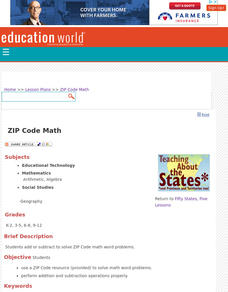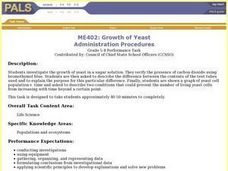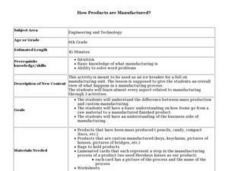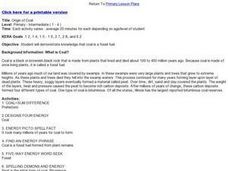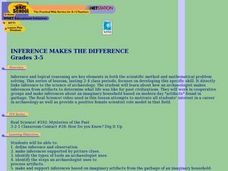Curated OER
Time Zones
Students solve time zone problems and chart travel around the world. In this time zone lesson plan, students learn about the history of time zones and view a time zone map. Students use the time zone map to solve time zone...
Curated OER
ZIP Code Math
Students add or subtract to solve ZIP Code Math word problems. A ZIP Code Math work sheet is included. This lesson combines math with geography quite nicely.
Curated OER
Roman Numerals
Fourth graders recognize Roman numerals and understand the value they stand for. in this Roman numerals lesson plan students identify the value of the numbers and understand the problems with reading them. Students complete a...
Curated OER
e, pi, and Exponential Functions
Learners investigate e, pi and exponents. In this calculus lesson, students define constants and non-constants using, pi, e and exponents as an example. They use the TI to work the problems in this lesson.
Curated OER
ME402: Growth of Yeast
Students investigate the growth of yeast in a sugar solution. They verify the pressure of carbon dioxide using bromothymol blue. Students are asked to describe the difference between the contents of the test tubes used and to explain...
Curated OER
Rules for Differentiation
Twelfth graders review the rules for derivatives and use them to solve problems. In this calculus lesson, 12th graders apply the power rules for derivatives correctly to solve equations. This assignment contains lots of examples of...
Curated OER
Get On Board
Students create a ticket table illustrating the cost of tickets by alternative transportation. In this number sense lesson, students write number sentences to compare and contrast difference information in their chart. Students figure...
Curated OER
Let's Trade
Second graders engage in a lesson which focuses on adding two-digit numbers and the regrouping process. They identify when the regrouping process is necessary and make appropriate "trades" to complete an addition problem.
Curated OER
When Close Enough is Good Enough
Students describe the difference between an estimate and a guess. They create reasonable estimates based on observation and hands-on activities. They synthesize estimated based on interaction with online activities.
Curated OER
How Products are Manufactured?
Sixth graders comprehend the difference between mass production and custom manufacturing. They have a basic understanding on how items go from a raw material to a manufactured finished product. Students have an understanding of the...
Curated OER
Headings and Titles
Fifth graders explain the difference between the title of a text and the headings. In this language arts instructional activity, 5th graders discuss how the heading is related to the main idea of a text. Additionally, students write...
Curated OER
Reviewing Facts Through 10
Manipulatives are always fun for children to use. They use connecting cubes and blocks to solve addition and subtraction word problems with numbers up to 10. They then play a math game and use their cube to create number sentences....
Curated OER
Integer Addition
Seventh graders explore the concept of integer addition. In this integer addition lesson, 7th graders tell stories involving addition and subtraction. Students walk on a number line given directions such as add 3 or add -2. Students play...
Pennsylvania Department of Education
Links Away: Looking Back and Moving Forward
Students explore fact families. In this math lesson, students use links to model a fact family. Students solve addition and subtraction problems.
Curated OER
Cars in Garages
First graders investigate whole numbers, and how numbers are often made up of smaller numbers. They determine the underlying concepts of addition and subtraction by examining how there is a finite set of number pairs for a given number....
Curated OER
Long Division
Fourth graders examine and demonstrate the steps of long division. They discuss why we use long division, and observe the teacher draw an illustration of a division problem. Students then solve a variety of long division problems,...
Curated OER
What is Coal?
Students receive instruction to answer the question "What is coal?". They then participate in several puzzles and problems to explore the subject of coal. They solve addition and subtraction problems and match letters with the letter...
Curated OER
Positive Futures Fair - Application of Year-Long Content Skills
Young scholars research a problem in the world today.
Curated OER
Inference Makes the Difference
Students explore how archaeologists make inferences from artifacts to explore what life was like in the past. In this archaeology lesson, students work in groups and make inferences about an imaginary household based on modern day...
Curated OER
Does the Decimal Point Really Make a Difference?
Fourth graders study the decimal dilemma and discover major math mistakes in the real world with cheeseburgers advertised for .99 cents each or colas for .89 cents each.
Curated OER
Matrix Analysis of Networks
Explore the connection between a finite graph, a directed graph, and a matrix. Graph lines and identify the relationship of matrices in real-world scenarios. Then use this information to work with a partner to plan and design a...
Willow Tree
Midpoint and Distance Formulas
The shortest distance between two points is a straight line. Learners use the Pythagorean Theorem to develop a formula to find that distance. They then find the midpoint using an average formula.
Virginia Department of Education
Volume of a Rectangular Prism
Fill the minds of your young mathematicians. A hands-on activity has learners fill in a rectangular prism with unit cubes to determine its volume. the exercise provides a great hands-on way for learners to connect the activity...
Curated OER
Use Google Maps to Teach Math
Capture the engagement of young mathematicians with this upper-elementary math lesson on measuring time and distance. Using Google Maps, students first measure and compare the distance and time it takes to travel between different...

